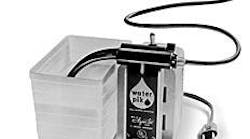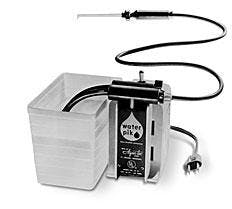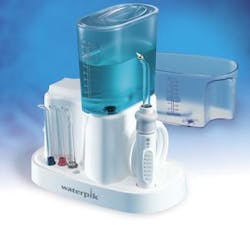by Deborah M. Lyle, RDH, MS
The joke is that you're "over the hill" when you turn 40. We don't think that's the case with the oral irrigator. The "little tip" still flushes away, reducing gingivitis.
It is 1962. The Nobel Prize for literature goes to John Steinbeck and for Medicine to Watson, Wilkins, and Crick for determining the structure of DNA. Gregory Peck and Anne Bancroft win the Academy awards for best actor and actress. Charles M. Schultz creates "Snoopy." Jackie Kennedy conducts a televised tour of the White House. John Glenn in Friendship 7 becomes the first American to orbit the Earth. Tom Cruise is born. And the first oral irrigator is introduced to the dental profession.
It has been 40 years since the introduction of the first oral irrigator. This success story behind the oral irrigator actually began in 1955 when a Fort Collins, Colo., dentist, Dr. Gerald Moyer, became interested in using irrigation in dentistry. He was aware of faucet-type attachments, but he felt that a superior product would be run by a motor to produce the optimum amount of pressure and flow to do the job. He was unsuccessful in finding motor companies in the Denver area who could develop a product small enough, so he tried to develop one himself.
In 1958, Dr. Moyer turned to John Mattingly, a friend, a patient, and, as luck would have it, a hydraulic engineer at Colorado State University. It took Dr. Moyer a year to convince Mattingly to help him with the project. Over the next several years, their time was devoted to the development of the irrigator. Mattingly made 145 pistons that did not work, but on the 146th try he was successful. However, the water came out pulsating and that was not the original plan. Sometimes things happen for the best. They settled for pulsating because they could get a patent based on the pulsating frequency.
By the fall of 1961, Mattingly had 30 handmade irrigators, affectionately known as the "Octopus." Dr. Moyer began loaning them to his patients. One particular patient used the irrigator for six months and swore it saved his teeth and made his mouth feel healthier. This patient was so convinced of the need to market the product that he raised money to finance a marketing program. He later became Waterpik's first president.
With the original investment money, the Aqua Tec Corp. was formed on February 27, 1962. The board of directors leased "the little green house" in Fort Collins for its company headquarters. Production took place in the basement, the shipping department and warehouse were in the living room and dining room, the kitchen housed the accounting department, and the two bedrooms were the executive offices. The board of directors also functioned as the "sales team" and attended dental conventions, promoting the irrigator as a prescription item. At a meeting in Dallas, the irrigator drew so much attention that the fire marshal was called to control the crowd!
In 1963, the company expanded distribution to include dental dealers and placed their first consumer ad in Life magazine. The company moved to its current location just a short distance from the original "headquarters" in 1964 and from 1965 to 1967 distribution expanded to include department, drug, and hardware stores.
In April 1967, the Aqua Tec Corp. was acquired by Teledyne, Inc. and was later known as Teledyne Water Pik. The current company is Waterpik Technologies and is a stand-alone company still manufacturing consumer oral healthcare products.
The dental profession and oral irrigation
Over the past four decades, oral irrigation has had its ups and downs with the dental profession. There were, and still are, different schools of thought regarding this therapy. Some clinicians feel it does not remove plaque and is ineffective. Some are fearful that patients will use the irrigator instead of floss. Others think it is too hard to use or it is only useful for special cases such as orthodontic or physically challenged patients.
These ideas indicate that many professionals apparently base their philosophy on what they learned or didn't learn in school, or the beliefs of colleagues or employers. Yet, as patients become more knowledgeable about both treatment and product research, it is time to begin to understand the science and truth about oral irrigation.
First, it is important to know that the studies on home irrigation (or patient applied irrigation) are very different from in-office irrigation where the medicament is delivered via a syringe, ultrasonic scaler, or mechanized device. Not only is the Waterpik™ oral irrigator 40 years old, but the research began then too. So let's go back to the early 1960s and begin the literature review. Put on your favorite tie-dyed shirt, a little Motown, or locate your favorite British invasion group on vinyl, and let's get started.
It doesn't remove plaque, does it?
We measure plaque by disclosing the teeth and using a standardized index that gives us a mean score for evaluation. What are we actually measuring with a plaque index? In most studies, we are measuring the surface area covered by supragingival plaque. This is certainly helpful. If there is a statistical change as we see in toothbrushing studies, we can conclude the product is effective in removing plaque, provided it is a well-designed study.
Using this type of measurement in irrigation studies has shown an inconsistency in reducing the plaque index. However, if early studies looked at the quality or composition of the plaque and not just the quantity or surface area covered, we may have had some different conclusions. What we must also consider is the reduction of subgingival plaque. Mechanical devices such as toothbrush, floss, and interproximal aids are primarily supragingival plaque removers. The subgingival access with these devices is minimal due to design and may not have any impact on subgingival microorganisms.
Oral irrigation has been shown to reach on average 50 percent of the pocket depth with a standard jet tip. There is one specialized tip called the Pik Pocket®subgingival irrigation tip that can reach 90 percent of a 6 mm pocket and 64 percent in pockets greater than or equal to 7 mm. When you are developing a self-care regimen for your patients with slight to moderate localized attachment loss, your expectations that they can keep the area clean with toothbrushing, flossing, or rinsing may be unrealistic and home irrigation may be necessary.
Irrigation studies later revealed a change in the composition of the subgingival microflora, which helps explain why there was a reduction in bleeding and gingivitis without a visible reduction in the plaque index or supragingival plaque.
Impact on clinical parameters
Numerous studies during the past 40 years confirmed the efficacy of water irrigation on clinical parameters with reductions in bleeding, gingivitis, and pocket depth. In addition, with the increased use of chemotherapeutics, the oral irrigator is the most effective self-care delivery device for antimicrobial agents - reaching farther into the pocket than rinsing. In some instances, an agent such as chlorhexidine may be diluted with the same or better results than rinsing full strength. Water irrigation consis-
tently has been shown to be efficacious. In some studies, though, the addition of an antimicrobial has resulted in greater reduction in clinical parameters.
You will need to evaluate if the addition of the agent resulted in enough of a clinical change in the study to warrant recommendation to your patient, taking into consideration the additional cost and side effects, when compared to just using water.
The age-old question of how irrigation works may finally be answered. Dr. Chaves concluded in his study that "the mechanism of gingivitis reduction by water irrigation is not related to supragingival plaque reduction but may involve specific host-microbiota alterations in the subgingival environment." A published 2000 study showed that daily irrigation with water reduced the pro-inflammatory cytokines interleukin-1 beta (IL-1beta) and prostaglandin E2 (PGE2). These cytokines, also called mediators, are products of the immune response that are associated with destructive changes in inflamed periodontal tissue, especially bone resorption. Concurrently, there was an increase in interleukin-10 (IL-10), which has recently been shown to inhibit the release of pro-inflammatory mediators and therefore is referred to as an "anti-inflammatory" mediator. This study shows the host modulation effect of water irrigation.
Your self-care recommendations
As you digest this information, ask yourself if the decision you made about recommending home irrigation is based on anecdotal information or sound science. The current buzzword in dentistry is evidence-based practice. To provide optimum care, you need to be knowledgeable about the available research for all dental hygiene procedures and therapies, as well as include these findings in your clinical decision-making process.
This is not an easy task, and it requires good critical thinking and evaluation skills. Perhaps you can begin by forming a study group and assigning topics or journals for review and then get together and discuss the information.
What you learned in school can become obsolete within a very short period of time. If you attended school during the 1970s you were probably taught that hand scaling was the gold standard and ultrasonic scalers were seldom used and all disease progression was based on the non-specific plaque hypothesis. It is now 2002. Ultrasonic scaling is considered standard therapy. We have shifted to the host modulation paradigm where the simple presence of pathogens is not enough to cause disease, but must exceed a critical threshold and overcome the host response. And oral irrigation is alive and well.
Irrigation is not a replacement for supragingival plaque control such as toothbrushing, flossing, or interproximal aids, but it completes the puzzle. Trish O'Hehir stated in her monthly Perio Reports publication, "If you are not recommending oral irrigation to your patients, or using it yourself, it's time to start. Oral irrigation was a good alternative for those who didn't floss, but now it should be considered a regular part of oral hygiene for everyone."
When you now plan treatment for patients with gingivitis, implants, localized slight to moderate loss of attachment, orthodontic appliances, prosthodontic replacements, diabetes, or past history of periodontal breakdown, think oral irrigation. Control of bacterial plaque is of limited value if there is not a concurrent improvement in gingival bleeding, gingival inflammation, or probing depth. The body of research on irrigation supports the reduction of these clinical parameters.
Oral irrigation is easy to learn and effective. Your patients view you as the expert with a comprehensive knowledge of current dental therapy to help them maintain optimal oral health.
Deborah M. Lyle, RDH, MS, is currently employed by Waterpik Technologies as the manager of professional marketing and education. She has presented numerous continuing education programs both nationally and internationally. Lyle also is a member of the ADHA Council on Education. She may be reached at [email protected].
Special needs patients
To date, only one study uses oral irrigation with implant patients. The patients presented with peri-implantitis and bleeding. They each irrigated using the low pressure Pik Pocket®tip and a diluted solution of chlorhexidine (0.06 percent). This was compared to the traditional method of rinsing with full strength chlorhexidine (0.12 percent). The irrigation group showed significantly greater reduction in plaque, gingival index, and calculus. Of clinical importance to the patient is the significantly less staining that occurred when chlorhexidine was delivered with the irrigator.
Many individuals with diabetes are unaware of the health implications of their disease. It sometimes can be a challenge for both the practitioner and patient to find the best self-care routine along with metabolic control. A recent study has shown that individuals with diabetes who irrigated twice daily with water improved both oral and systemic health parameters better than those who only brushed and flossed. The reduction of plaque, gingivitis, and bleeding were expected due to the significant body of evidence supporting this result with irrigation. Of interest were the significant improvements in serum cytokine levels of IL-1beta and PGE2 and reactive oxygen species (ROS). Along with pro-inflammatory cytokines, ROS (also called oxygen free radicals) are a component of the destructive process.








